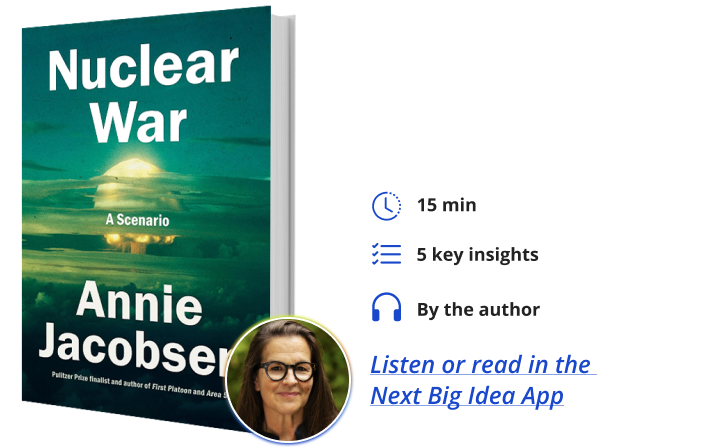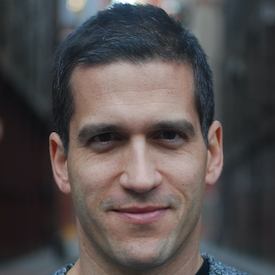Annie Jacobsen is an investigative reporter who writes about war, weapons, U.S. national security, and government secrets. Her work has earned her numerous distinctions, including being a Pulitzer Prize finalist. Among her many projects, she has written six books about military and intelligence programs—involving the CIA, The Pentagon, and DARPA—all designed to prevent or deter Nuclear World War III. For this latest book of hers, she asks: what happens if deterrence fails?
Below, Annie shares five key insights from her new book, Nuclear War: A Scenario. Listen to the audio version—read by Annie herself—in the Next Big Idea App.

1. Nuclear war is insane.
Today, there are nine nuclear-armed nations with more than 12,500 nuclear weapons ready to be used. Professor Brian Toon is one of the original five authors of the Nuclear Winter theory (along with his former professor Carl Sagan), and he reminded me that if you’re living in an American city, big or small, there’s a nuclear weapon pointed directly at you right now. And the U.S. government has nuclear weapons pointed directly at hundreds of cities across the world. To be exact, as of 2024, America has 1,770 deployed nuclear weapons, most of which are set to ready-for-launch status, 400 of which (the Minuteman ICBM) can launch in as little as 60 seconds.
Were a nuclear weapon to strike America, U.S. policy dictates a nuclear counterattack. This response would almost certainly set off a series of events that would quickly spiral out of control. General Robert Kehler, former commander of U.S. Strategic Command, told me that in a nuclear war scenario, “The world could end in the next couple of hours.”
Consider that Vladimir Putin recently said he is “not bluffing” about the possibility of using weapons of mass destruction. North Korea has accused the U.S. of having “a sinister intention to provoke a nuclear war.” UN Secretary-General António Guterres recently warned, “Humanity is one misunderstanding, one miscalculation away from nuclear annihilation…This is madness.”
2. Launch on Warning.
As odd as this may seem, the U.S. maintains a nuclear launch policy called “Launch on Warning.” This means that if a military satellite indicates America is under nuclear attack, and a second early-warning radar confirms that information, then the president of the United States launches nuclear missiles in response—before any nuclear bomb strikes U.S. soil. Said differently, the U.S. doesn’t wait to absorb the nuclear blow.
Some people say this isn’t accurate. Former Secretary of Defense William Perry sets the record straight. He told me: “Once we are warned of a nuclear attack, we prepare to launch. This is policy. We do not wait.” Period. This is because the U.S. president has sole authority to launch nuclear weapons. He asks permission from no one. Not the Secretary of Defense, not the Chairman of the Joint Chief of Staff, not the U.S. Congress.
“The U.S. president has sole authority to launch nuclear weapons.”
You may ask, How could this be in a democracy predicated on checks and balances? But Congress confirms this is a fact: “The authority is inherent in his role as commander in chief…” The president “does not need the concurrence of either his military advisors or the U.S. Congress to order the launch of nuclear weapons.”
3. Six minutes to Armageddon.
Once the president learns from his nuclear command and control team that he must act, he has only six minutes to respond. To “respond” means responding with our own nuclear weapons. President Ronald Reagan lamented in his memoir that six minutes is an irrational amount of time to “decide whether to release Armageddon! …Six minutes to decide how to respond to a blip on a radar scope…How could anyone apply reason at a time like that?”
Yet, the president must respond anyway. In this six-minute window, the president must decide how many nuclear weapons to use and which targets to strike—while also being briefed on estimates of how many tens of thousands, or millions of people, would be instantly incinerated, with an almost equal number dying days, weeks, and months later from radiation poisoning. All this to consider under a literal ticking clock.
4. An ICBM cannot be re-directed or recalled.
An ICBM is an intercontinental ballistic missile. It is a weapon system that is central to nuclear war, along with nuclear bombers and nuclear armed submarines.
The time it takes to get an ICBM from a launch pad in Russia to the United States was precisely determined in 1960, shortly after the ICBM had been invented. The Pentagon’s chief scientist, Herb York, wanted to know precisely how long it would take for one of these mass-extermination rockets to get here. These documents, jealously guarded by defense officials, were found by me inside an archive that houses York’s personal papers at the Giesel Library in San Diego.
York hired a group of defense scientists, called the Jason scientists, to whittle the ICBM travel time down to its most accurate form. Together, they concluded that it takes 26 minutes and 40 seconds to go from launch to annihilation. The Jason scientists calculated that an ICBM’s travel time occurs in three very simple phases of flight.
- Boost Phase, where the rocket launches and travels upwards into space, lasts five minutes.
- Midcourse Phase, where the weapon flies through space to get across the Earth very fast, lasts 20 minutes.
- Terminal Phase, where the warhead reenters the atmosphere and detonates on a city, lasts 1.6 minutes (100 seconds).
These calculations were done when the U.S. and Soviet Russia were the only nuclear armed nations, whereas now we have nine countries with nuclear weapons: the United States, Russia, China, France, the United Kingdom, Pakistan, India, Israel, and North Korea. Given North Korea’s geographic location, the launch-to-target time from the Korean peninsula to the East Coast of the United States is slightly longer. MIT professor emeritus, ballistic missile expert, and former Pentagon advisor Ted Postol did the math for me: It is 33 minutes.
Once an ICBM has been launched, it cannot be redirected or recalled. The papers stashed away in Herb York’s dusty archives forewarned the world of nuclear Armageddon. The clock is still ticking.
5. Bolt out of the Blue attack.
A Bolt out of the Blue attack is how U.S. Nuclear Command and Control refers to an “unwarned large [nuclear] attack.” In plain English, it’s a sneak attack. A deadly first strike. Andrew Weber, the former Assistant Secretary of Defense for nuclear, chemical, and biological defense programs, told me, “A Bolt out of the Blue attack against D.C. is what everyone in D.C. fears most.”
“State-of-the-art climate modeling predicts five billion humans would die.”
Since the early 1950s, the U.S. government has spent trillions of dollars preparing to fight a nuclear war, while also refining protocols meant to keep the U.S. government functioning after hundreds of millions of Americans become casualties of an apocalyptic-scale nuclear holocaust. Because the Pentagon is a top target for a strike by America’s nuclear-armed enemies, in the scenario in my book, Washington, D.C. gets hit by a Bolt out of the Blue attack with a one-megaton thermonuclear bomb.
Nuclear war is the only scenario—other than an asteroid strike—that could end civilization in a matter of hours. The soot from burning cities and forests would blot out the sun and cause a nuclear winter. State-of-the-art climate modeling predicts five billion humans would die. In the words of Nikita Khrushchev, “The survivors will envy the dead.”
The threat of nuclear war is a reality of the world in which we all live. The nuclear war scenario proposed in my new book could happen tomorrow. Or later today.
To listen to the audio version read by author Annie Jacobsen, download the Next Big Idea App today:
































